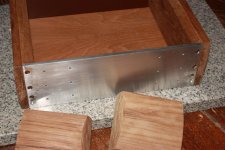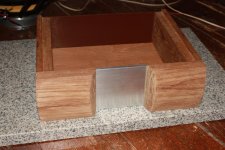Hi Gents ,
can anyone suggest a volume control to use with this build ... Novice rears his ugly head again ...
cheers , Rich
can anyone suggest a volume control to use with this build ... Novice rears his ugly head again ...
cheers , Rich
Hi Andrew ,
this is available to me from a fellow forum member .... http://www.rapidonline.com/netalogue/specs/66-0226.pdf
Now an in put selector ... looking for three inputs ... Pearl 2 , DAC and a spare
Just starting to collect parts .
Rich
this is available to me from a fellow forum member .... http://www.rapidonline.com/netalogue/specs/66-0226.pdf
Now an in put selector ... looking for three inputs ... Pearl 2 , DAC and a spare
Just starting to collect parts .
Rich
Last edited:
I have no idea what your budget is, but if that seems good value for your money, then go for it.
I wasted a ton of cash on my amp build ... 20 quid seems sensible . I did find out that a lot of my problems were caused by working with far higher temp when soldering .
New digital station .. Start with this little project this time 😉
I want good solid quality parts without getting boutique silly . I can always change parts later .
I would like to use a split rail supply ,but everything gets confusing in the thread . I'm on page 56 and the design just keeps changing . I wish there was a beginners area here on the forum . I'm sure folks get frustrated with me cluttering up their thought process with very basic questions .
Rich
New digital station .. Start with this little project this time 😉
I want good solid quality parts without getting boutique silly . I can always change parts later .
I would like to use a split rail supply ,but everything gets confusing in the thread . I'm on page 56 and the design just keeps changing . I wish there was a beginners area here on the forum . I'm sure folks get frustrated with me cluttering up their thought process with very basic questions .
Rich
A balanced impedance connection must have the impedances balanced (matched) both at the transmit end and at the receive end. The B1 input will be the receive end. All the components that determine it's input impedance MUST be matched to a an accuracy you have determined is adequate for your use. This includes the Capacitor loading.
The output of the B1 is the transmit end. The resistor on the output dominates the send impedance, you can probably get away with matching the output resistor only and use nominal +-5% components for all the others.
Okay, do I understand it right that the exact value of the C's is not the most important, as long as they are carefully matched?
Now an in put selector ... looking for three inputs ...
Rich
this Lorlin is real cheap http://docs-europe.electrocomponents.com/webdocs/007a/0900766b8007a1e8.pdf
Lucas Stabilty is probably a lot more solid, with longer life
cost more, but still cheaper than 'audiophile' parts
I doubt you can actually hear any difference
or maybe the cheap Lorlin actually 'sounds' better
as long a they function properly
but then, a nice feel gives confidence of good sound too 😛
remember you need 'brake before make' (BBM) for a signal switch
and for building resistor attenuator it should be 'make before brake' (MBB)
I think it is
Yes, if 10uF lets all the audio through then whether it is 9.3uF or 10.9uF does not really matter.Okay, do I understand it right that the exact value of the C's is not the most important, as long as they are carefully matched?
But as far as the balanced impedance connection is concerned, the two halves (hot & cold) of the connection must have the same impedance, i.e. same resistance and same capacitance to a very tight tolerance. Aim for better than 0.1%
The two channels of a stereo connection do not need to match each other, 1% or 2% is probably inaudible.
Make before break is important to an attenuator switch. It prevents a loud click and with some systems could result in maximum signal going to the receiver for very loud noise.remember you need 'brake before make' (BBM) for a signal switch
and for building resistor attenuator it should be 'make before brake' (MBB)
I think it is
I am not sure that break before make is correct for selector switching/muting.
The DCB1 has a break before make relay as the delay switch. While it is open the receiver sees an open circuit (near infinite impedance) on it's input and uses that as an aerial to pick up whatever it can.
Selector relays and selector switches that go open will do the same to any receiver.
Some receivers will oscillate if the input is momentarily left open.
I am not sure that break before make is correct for selector switching/muting.
hmm, and what happens when using using MBB switch ?
will there be two sources connected in paralel, momentarily ?
any audible effects ?
if using 4pole switch breaking both hot signal and ground, I guess it would be best to at least have MBB on the ground connection ?
Yes, two source resistances will momentarily be connected to the receiver input. = no open circuit input,what happens when using using MBB switch ?
will there be two sources connected in parallel, momentarily ?
any audible effects ?
Yes, you will hear two sources playing together.
will there be two sources connected in parallel, momentarily ?
any audible effects ?
Other than hearing both of the sources at once?
ok
well, if no other side effects, and using a 4pole breaking ground connection too, I guess MBB should be the choise
thanks
well, if no other side effects, and using a 4pole breaking ground connection too, I guess MBB should be the choise
thanks
walwart?
Hmm, what is the recommended walwart for the B1 buffer?
I've picked up a few 12vdc 500ma adapters for my buffer at a surplus electronic shop and one has already failed.
Hmm, what is the recommended walwart for the B1 buffer?
I've picked up a few 12vdc 500ma adapters for my buffer at a surplus electronic shop and one has already failed.
Thanks, your right. I am using a 24vdc for the other b1 buffer I've got.
I must have mixed it up with my lightspeed attenuator.
I must have mixed it up with my lightspeed attenuator.
24v is good - it's close to the rating of the caps, which is why NP said 24v is the upper limit.
- Home
- Amplifiers
- Pass Labs
- B1 Buffer Preamp



